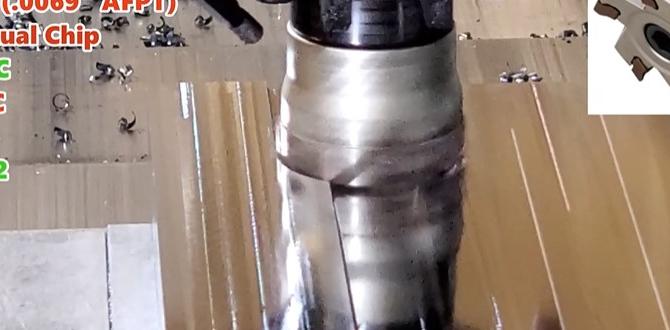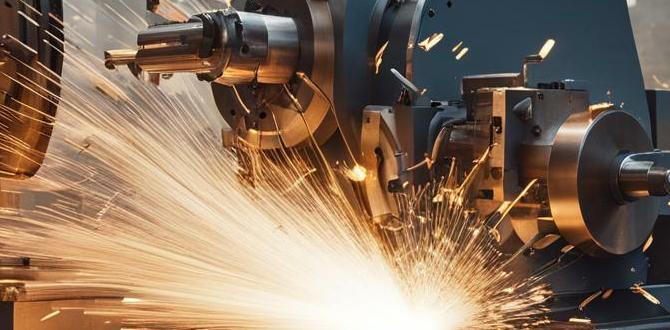Carbide end mills are your secret weapon for achieving super precise cuts in your machining projects, making them ideal for jobs demanding tight tolerances.
Working with metal can be tricky, especially when you need your parts to fit together perfectly. Getting those super-precise dimensions, like matching a thousandth of an inch, can feel like a huge challenge. Sometimes, even with the best setup, your cuts just don’t come out as exact as you need them to. This can be frustrating, leading to parts that don’t quite fit or projects that don’t look quite right. But what if there was a tool that made achieving these tight tolerances a lot easier? That’s where the humble, yet mighty, carbide end mill shines. In this guide, we’ll uncover why these tools are a machining game-changer for precision work and walk you through how to use them to get those perfect fits you’re after. Let’s dive in and unlock the secret to your most precise cuts yet!
What Exactly is an End Mill, and Why Carbide?
Before we get into the nitty-gritty of tight tolerances, let’s make sure we’re on the same page about what an end mill is. Think of an end mill as a milling cutter that has cutting edges on its shank, not just on its tip. This means it can cut horizontally into a material (plunge cutting) as well as make side cuts. It’s a versatile tool used in milling machines to create slots, pockets, profiles, and much more.
Now, why specifically carbide? This is where the magic for tight tolerances happens. Carbide, formally known as tungsten carbide, is a composite material made from a mixture of tungsten carbide powder and a binder metal, usually cobalt, pressed and sintered together. This process creates an incredibly hard and brittle material.
| Material | Hardness (HV30) | Strength | Brittleness |
|---|---|---|---|
| High-Speed Steel (HSS) | ~700 | Good | Moderate |
| Cobalt (HSS) | ~850 | Better than HSS | Slightly more brittle than HSS |
| Carbide | ~1400-1800 | Good (particularly compressive strength) | High |
This extreme hardness is the key. It allows carbide end mills to cut harder materials and at much higher speeds than traditional High-Speed Steel (HSS) tools. For us machinists, especially those chasing precision, this translates to:
Better Edge Retention: Carbide stays sharp for longer, meaning it cuts consistently without deforming as much. This consistency is vital for accuracy.
Less Deflection: Because of its rigidity and hardness, a carbide end mill is less likely to bend or deflect under cutting forces compared to softer materials like HSS. Less deflection means the tool follows your programmed path more accurately, leading to tighter tolerances.
Higher Cutting Speeds: While this might seem less relevant for precision, higher speeds can sometimes mean a smoother surface finish and reduced heat build-up in the workpiece. Less heat can mean less thermal expansion, contributing to accuracy.
The Challenge of Tight Tolerances
In machining, a “tolerance” is the acceptable variation in a dimension. For example, if a part needs to be 1.000 inches in diameter and the tolerance is +/- 0.001 inches, then any diameter between 0.999 and 1.001 inches is considered acceptable. “Tight tolerances” means this acceptable variation is very small – often in the ten-thousandths or twenty-thousandths of an inch (0.000X” or 0.0000X”).
Achieving these tight tolerances isn’t just about having a good machine; it’s about the interplay of many factors:
Machine Rigidity: A wobbly machine will translate that wobble into your part.
Tooling: The cutting tool itself needs to be precise, sharp, and rigid. A dull or deflective tool will wander.
Workholding: How securely is your workpiece held? If it shifts even slightly, your dimensions will be off.
Cutting Parameters: Spindle speed, feed rate, and depth of cut all influence how the tool cuts and how much force is applied.
Thermal Expansion: Machines and workpieces heat up during machining. This heat causes them to expand, which can ruin tight tolerances if not accounted for.
This is where our specific tool, the “carbide end mill 1/8 inch 1/2 shank standard length for mild steel tight tolerance,” comes into play. The 1/8-inch diameter is perfect for intricate details and smaller pockets often found in precision parts. The 1/2-inch shank provides good rigidity, and its “standard length” means it’s not overly long, further reducing the potential for deflection. When paired with mild steel, a common and workable material, this specific end mill becomes an excellent choice for accuracy.
Choosing the Right Carbide End Mill for the Job
Not all carbide end mills are created equal, especially when precision is the name of the game. For tight tolerances, you’ll want to pay attention to a few key features:
1. Number of Flutes
Flutes are the helical grooves that run along the cutting edges of an end mill. They help evacuate chips and create the cutting surfaces.
2-Flute End Mills: Generally better for plunging and slotting. They have more open flute space, which is good for chip clearance in softer materials like mild steel. For tight tolerances, their larger chip gullets can help prevent chip recutting, which can ruin a surface finish and dimensional accuracy.
3-Flute End Mills: A good all-around choice. They offer a balance between cutting efficiency and chip evacuation. They can be used for slotting, profiling, and general milling.
4-Flute End Mills: Excellent for profiling and finishing in harder materials. They provide a better surface finish and can handle higher feed rates. However, with less chip clearance, they can be more prone to “chatter” or chip packing in softer, “gummy” materials like mild steel, potentially affecting accuracy if not managed.
For tight tolerances in mild steel, a 2-flute or 3-flute carbide end mill is often the preferred choice. A 2-flute offers superior chip evacuation for plunging and slotting, reducing the risk of material buildup that can lead to inaccurate cuts. A 3-flute provides a good compromise if you’re doing a mix of operations.
2. End Mill Geometry
Beyond the flutes, the actual shape of the cutting end matters.
Square End Mills: The most common type. They have a flat, square end, ideal for creating square pockets, shoulders, and profiles. These are your go-to for precise boxy features.
Ball End Mills (Ball Nose): Have a rounded, hemispherical tip. Used for creating rounded pockets, 3D contours, and fillets.
Corner Radius End Mills: A hybrid with a small radius on the corners of a square end. This radius can help strengthen the cutting edge and reduce stress, leading to more consistent cuts, often at the expense of a perfectly sharp internal corner, but improving surface finish and tool life. For extreme precision where sharp internal corners are paramount, a square end mill geometry is often preferred, but requires more care.
For achieving tight tolerances on square features, a high-quality square end mill is usually the best bet.
3. Coating
While not all carbide end mills have coatings, some do, and they can offer advantages:
Uncoated: Most common for general carbide end mills.
TiN (Titanium Nitride): A standard, general-purpose coating that adds hardness and reduces friction. Good for many applications.
TiAlN (Titanium Aluminum Nitride): Offers better performance at higher temperatures, making it suitable for harder materials or higher cutting speeds.
ZrN (Zirconium Nitride): Good for aluminum and other non-ferrous materials due to its non-reactive nature.
For mild steel and general precision work, an uncoated carbide end mill is often sufficient and cost-effective. If you’re pushing speeds and feeds or working with tougher steels, a coating might be beneficial, but for basic tight tolerance work, focus on end mill quality and proper machining practices first.
Best Practices for Using Carbide End Mills for Tight Tolerances
Simply owning a carbide end mill isn’t enough; using it correctly is crucial for achieving that “genius” level of precision. Here are the essential practices:
1. Machine Setup is Paramount
Rigidity is King: Ensure your milling machine is as rigid as possible. Check for play in the ways, spindle runout, and ensure all gibs are properly adjusted. A solid machine is the foundation of accurate machining.
Tool Holder Precision: Use a high-quality tool holder and collet. Runout in your tool holder can cause the end mill to wobble, directly impacting the diameter of the cut and the accuracy of the part. ER collets or a hydraulic tool holder are excellent choices for reducing runout.
Workholding: Secure your workpiece positively. Use clamps that don’t distort the part, vises, or specialized fixturing. If the part moves during cutting, you’ve lost your precision. For critical parts, consider using a test indicator to verify the position of your workpiece before and after machining operations.
2. Carbide-Specific Cutting Parameters
Carbide tools operate differently than HSS. They are harder but more brittle, so they don’t like shock or excessive heat concentrated in one spot.
Speeds and Feeds: This is critical. Carbide generally runs much faster than HSS. For a 1/8-inch carbide end mill in mild steel, you might be looking at spindle speeds of 10,000-20,000 RPM or even higher, depending on your machine and the specific carbide grade. Feed rates need to be high enough to ensure that each flute takes a small chip, preventing chip recutting and chatter.
A good starting point for a 1/8″ 2-flute carbide end mill in mild steel might be around 15,000 RPM and a feed rate of 10-15 inches per minute (IPM).
Always consult manufacturer recommendations for your specific end mill. Websites like GTool’s Carbide Speed and Feed Calculator can be a great resource to get you in the ballpark.
Depth of Cut (DOC) and Width of Cut (WOC): For roughing (material removal), you can take relatively deep cuts, but for finishing passes where precision is key, these should be very shallow.
Finishing Pass: A common technique for tight tolerances is to make a light finishing pass. This might be a DOC of 0.005″ to 0.010″ and a WOC of around 0.020″ to 0.040″ (i.e., taking a shallow slice of material). This pass is designed to clean up the surface and achieve the final dimension without significant cutting forces that could cause deflection.
3. Chip Evacuation and Lubrication
Keep it Clean: Ensure chips are effectively cleared from the cutting area. For mild steel, using a coolant or cutting fluid is highly recommended. It lubricates the cut, cools the tool and workpiece, and flushes chips away. This is vital for preventing heat buildup and chip welding, both of which degrade accuracy.
Form Lubricant: For small operations in a home shop, a spray bottle of cutting fluid or a drip system can work well. For more advanced setups, flood coolant systems are ideal.
4. Tool Condition and Usage
Sharpness: Even carbide dulls. While it lasts longer than HSS, a dull carbide end mill will rub rather than cut, generating heat and forcing the tool to deflect. If you notice increased cutting forces, poor surface finish, or accuracy degradation, it’s time to change the tool or get it reground.
Avoid Stepping: Whenever possible, try to make your cuts in a single pass for the final dimension. Multiple passes can introduce cumulative errors.
Climb Milling vs. Conventional Milling: For finishing passes aiming for tight tolerances and a good surface finish, climb milling is often preferred when possible. In climb milling, the cutter rotates in the same direction as the feed. This tends to produce a better surface finish and can reduce forces that might cause the tool to lift. However, it requires a machine free of backlash or a machine with specific climb milling capabilities. If your machine has significant backlash in the feed mechanism, conventional milling might be safer to prevent the tool from digging in erratically.
Step-by-Step Guide: Milling a Precision Pocket with a Carbide End Mill
Let’s walk through an example: milling a precise pocket in a piece of mild steel plate to a specific dimension.
Objective: Mill a rectangular pocket 0.500″ wide by 1.000″ long, with a tolerance of +/- 0.001″ for both width and length, and to a depth of 0.100. We’ll use a 1/8″ 2-flute carbide square end mill.
Tools & Materials:
Milling machine (e.g., a benchtop CNC or manual mill)
1/8″ 2-Flute Carbide Square End Mill
High-quality R8 collet or appropriate tool holder
Mild Steel workpiece (e.g., A36 or 1018 steel)
Machinist’s Vise or clamp fixturing
Cutting fluid or coolant
Calipers or a micrometer for measurement
Test indicator (optional but recommended for precision)
Safety glasses and appropriate PPE
Steps:
1. Secure the Workpiece:
Clean the surface of your steel.
Securely mount the steel plate in your vise. Ensure the vise jaws are clean and free of debris. Tighten firmly.
Optional: Use a test indicator to check for any wobble or movement in the workpiece.
2. Install the End Mill:
Insert the 1/8″ 2-flute carbide end mill into a clean collet.
Insert the collet into the milling machine spindle. Tighten the collet securely. Ensure the tool is fully seated and runout is minimal.
3. Set Up Machine Parameters:
Based on our earlier discussion, let’s aim for:
Spindle Speed: 15,000 RPM
Feed Rate: 12 IPM
Coolant: On
For depth: Roughing pass at 0.095″, finishing pass at 0.100″.
4. Establish Zero and Program (or Set Up Manually):
If using a CNC, program your toolpaths. For a pocket, you’ll typically use a spiral or zig-zag pattern for roughing and a clean-up pass around the perimeter for finishing.
If manual, you’ll use your machine’s handwheels.
Locate Workpiece Zero: Carefully bring the end mill into contact with the workpiece surface to set your Z-axis zero for depth. For X and Y axes, surface the sides of the block to establish your starting square.
Pocket Dimensions: You’ll need to position the end mill to start cutting the pocket. For a 0.500″ x 1.000″ pocket using a 0.125″ end mill, you will need to offset your cutting paths from the true “inside” corner. The center of the 0.125″ end mill will be 0.125″ away from where the final wall will be.
5. Roughing Pass:
Engage the coolant.
Start the spindle at 15,000 RPM.
Feed the end mill down for the roughing depth (e.g., 0.095″). Use a zig-zag or spiral pattern to remove most of the material. Ensure good chip flow.
Once the rough depth is reached, clear out any remaining material in the pocket bottom. If doing zig-zag, a final perimeter pass at roughing depth can ensure a flat bottom.
6. Finishing Pass(es):
This is where precision happens.
Set Final Depth: Move the Z-axis to the final depth of 0.100″.
Clean-up Pass: With the spindle still at 15,000 RPM and feed at 12 IPM (or slightly slower for a super-fine finish), carefully perform a perimeter pass around the inside of the pocket. Alternatively, a light zig-zag pass over the entire pocket floor can ensure flatness.
“Spring Pass” (Advanced): For extremely tight tolerances, sometimes a “spring pass” is done. This is a light, shallow pass (e.g., 0.001-0.003″ DOC) with no engagement of the Z-axis after the final full-depth pass. The idea is that if the tool deflected slightly on the final pass, this super-light pass will remove that tiny bit of excess material from the outside wall, allowing the material to “spring back” more uniformly to the true size. This requires a very rigid setup and a sharp tool.
7. Measure and Verify:
* Once cutting is complete and chips are cleared, allow the workpiece to cool down if any significant heat was generated





